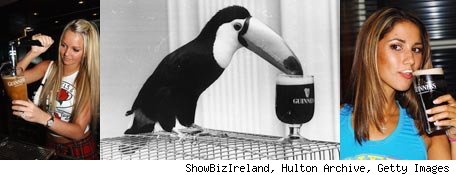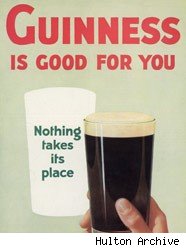Written by Michael B. Dougher

In 1759 Arthur Guinness first began to brew his eponymous Irish stout, and probably sometime in 1760, people started making crap up about it.
Like shamrocks, freckles and bar fights, Guinness has become an icon of the Emerald Isle, known around the world for its impenetrable color, its complex pouring ritual, and its ability to balance well on a toucan’s beak. It’s also known for the wild rumors associated with it, from the common barfly’s claim of better-tasting pints in the old country to conspiracy theories of macabre secret ingredients. Just in time for St. Patrick’s Day, Asylum goes MythBusters on your favorite draught. Boston, we’re looking at you.
Myth Number 1: Guinness is heavy in calories … False
Guinness weighs in at 125 calories per 12-oz. serving. But wait, who drinks a 12-oz. Guinness? Nobody, since a pint is 16 oz. (20 for the lucky stiffs in the motherland). Do the math and you get about 170 calories per 16-oz. serving. Guess how many are in a 16-oz. Strawberry Surf Rider smoothie from Jamba Juice? 330. Thank us later, ladies.
Myth Number 2: Guinness is supposed to be warm … False
Guinness reports its draught is best stored at 42.8 degrees. Your average fridge is between 35 and 38, which is a bit on the chilly side. Unfortunately, most beer coolers in bars are even colder to accommodate our thirst for “ice cold” beer. Regardless, 43 degrees is neither warm nor room temperature. The obvious solution is to order two at a time, so one is always warming up!
 Myth Number 3: ‘Guinness for strength’ … Undetermined
Myth Number 3: ‘Guinness for strength’ … Undetermined
The famous ‘Guinness is good for you’ and similar advertisements from the 1930s — great marketing ploy, but just keep in mind it came about in the 1930s, when you could still claim your product did anything and not get in trouble with the law. We happen to think a pint of Guinness is the most important meal of the day, but we have no scientific evidence to back that up. Your mileage may vary. If Guinness does give you a boost, it’s probably more in the “liquid courage” category.
Myth Number 4: The flavor of Guinness stems from nefarious sources … False
The more outrageous stories about Guinness include the ones about how dead rats were found at the bottom of the vats in the St James’s Gate brewery in Ireland, thus explaining the unique taste of stout. Other stories have circulated that Guinness is actually filtered through lamb’s blood to get its taste. This one is classic barroom BS at its finest. Guinness has been the victim of more Snopes-worthy urban legends than any other libation, except maybe Corona. The basics of Guinness are barley, hops, yeast and water … from the Skull and Bones Society. Guinness derives its toasted flavor, which tastes anywhere from coffee to chocolate, and bitter hint from the manner in which its malted barley is roasted and the amount of hops used. The creamy taste of the head is a result of nitrogen bubbles released during the pouring process.
Myth Number 5: The St. James’s Gate brewery produces different kinds of Guinness for various markets … Kinda
Guinness is available in 100 countries and is brewed in nearly 50 of them, using locally sourced ingredients like water. Therefore, one could argue (and we know you will) that any Guinness brewed outside Dublin is materially different. The top five selling markets? (In order) Great Britain, Ireland, Nigeria, the U.S. and Cameroon. We were surprised by those two, too.
Myth Number 6: Water from the River Liffey in Dublin goes into Guinness … False
While the St. James’s Gate brewery sits next to the river, the water used to make Guinness comes from the Wicklow mountains to the south.
Myth Number 7: Guinness in a can is different from draught Guinness … Confusing
Guinness is available in draught, Extra Stout, and Foreign Extra. Draught comes in cans, bottles and, well, draught. Extra Stout comes only in bottles and Foreign Extra comes in bottles, cans and an Extra Smooth variety. Got all that? Good.
Myth Number 8: Strict vegetarians can’t drink Guinness … True
The production of the stout involves the use of isinglass, a byproduct of the fishing industry derived from dead fish. Isinglass is used as a fining agent for settling out suspended matter in the beer vat, and while it’s kept at the bottom of the tank, some isinglass may end up in the final product. So if you’re the type who avoids gelatin and whey in your diet, you’re out of luck. We can only imagine the histrionics this revelation might spark from PETA.
Myth Number 9: Guinness is black … False
Look closer and you’ll see that Guinness actually has a ruby red color, due to how the malted barley is roasted. Hint: This one is an easy way to win $5 from your friends.
Myth Number 10: The Guinness in Ireland is much better than the Guinness served in the United States … Up to you
While we would never judge a fellow tippler for his esteemed critique of the palate (especially after 2-for-1 atomic-wing night), this granddaddy of Guinness myths is usually spouted from the condescending lips of a recently returned study-abroad student, suddenly eminently more cultured than we are for spending three months puking outside the American-themed bar in some foreign city. Whether a pint is better in the Old Sod than it is here really has to do with a lot of factors — mainly, how many you’ve had.
WTF, the only myth to debunk is “Guiness makes women s boobs bigger” period. 😀
Hey! that foreign exchange student was me~! Been, oh, 30 years ago. But I got tanked in real English pubs, and guiness was the only thing, with an occasional Newcastle Brown Ale. I’ve never had a Guiness here in US that tasted the way I remember it over there, but – how good could my memory have been!?
Hmmm… In regards to number 10, ‘a lot of factors’ is right, and ‘mainly, how many you’ve had’ is a bit of a cop out.
Having lived in both the US and Ireland for multiple years, I think the taste difference is largely significant because:
-Where stout nor nitrogen-based beer is not prevalent (nor craft beers), the bartenders may not be trained properly to pour a proper pint. I’ve had this problem with a lot of beers in the US.
-If stout isn’t popular somewhere, then the lack of volume being drank may mean the kegs don’t get emptied quick enough and the pipes in the draught may not be kept as clear or clean. I think this may have something to do with it. I’ve had problems with imported Irish draught stouts outside of Ireland feeling quite flat.
-I noticed, too, that not as many people actually drink Guinness in Ireland anymore as one might expect. However, one thing Ireland has that other nations that serve Guinness might not have is a fleet of Guinness inspectors who travel around the island visiting pubs and making sure the pipes are clean and the beer is being served properly. This certainly helps contribute to a quality pint.
-Having had Guinness in different places around Ireland, initially I felt that more distance from St. James Gate meant a worse pint. However, I think the reality is actually that finding a place that serves a high volume of Guinness is actually a bigger factor. Locals have told me this also (recommending certain pubs in their city for the taste of certain beers).
-And you said it yourself: Guinness brewed outside Dublin is materially different, especially because of water, but I’m going to take a wild guess and say that the equipment may vary as well.
I actually prefer the cans with the widgets in them to a Guinness on tap when outside of Ireland.
Yeah, I dunno. I’ve spent some quality time in downtown Dublin, just down the street from the brewery, and found Guiness is the Bud Light of Ireland: ubiquitous, though not everyone is drinking it, 3 out of 4 beers sold seems to be dark, creamy, Guiness goodness. As for the taste difference between there and elsewhere, I don’t think there’s any real difference. I mean, if you’re one of those people who can open up a bottled water and name the spring it came from, then maybe. But if you’re the average Guiness lover, one poured at the “smallest pub in Dublin” (http://dublin-in-pictures.blogspot.com/2008/06/smallest-pub-in-dublin.html) or at some big trendy meat market in the US is gonna taste about the same. Guiness does a fantastic job of ensuring quality control with brewers abroad to ensure consistency. Honestly, after a couple pints, you barely know where you’re at, let alone, what you’re drinking. 😉
Frankly, I love their product and have been trying (fruitlessly) to clone it in homebrew recipes. Ah well, guess I need more samples to taste until I get it right. 😉
Webmaster,
Nice writing style. I clicked an ad for ya
Regarding the Guinness being better in Ireland than the USA – this is pretty much true. One of the main factors in determining how good a pint is, is the rate of turnover or a keg. The longer the beer is left in the pipes, the more bitter it becomes. Therefore, the countries in which the most Guinness is drunk have a faster turnover of kegs and the taste is noticeably better. Of course, there are certainly some pubs in the states with high turnovers of Guinness, and therefore tasty pints as well, but in general we drink more in Ireland. There's also the work of the Guinness Quality Team, who spend their days driving the length and breadth of Ireland to ensure the Guinness meets the required standards.
Seriously – if you go to Mulligans of Poolbeg Street, or Kehoes (both in Dublin) you'll taste some of the best Guinness in the world. Kelly's Cellars in Belfast do an equally stout-licious pint.
Regarding the Guinness being better in Ireland than the USA – this is pretty much true. One of the main factors in determining how good a pint is, is the rate of turnover or a keg. The longer the beer is left in the pipes, the more bitter it becomes. Therefore, the countries in which the most Guinness is drunk have a faster turnover of kegs and the taste is noticeably better. Of course, there are certainly some pubs in the states with high turnovers of Guinness, and therefore tasty pints as well, but in general we drink more in Ireland. There's also the work of the Guinness Quality Team, who spend their days driving the length and breadth of Ireland to ensure the Guinness meets the required standards.
Seriously – if you go to Mulligans of Poolbeg Street, or Kehoes (both in Dublin) you'll taste some of the best Guinness in the world. Kelly's Cellars in Belfast do an equally stout-licious pint.